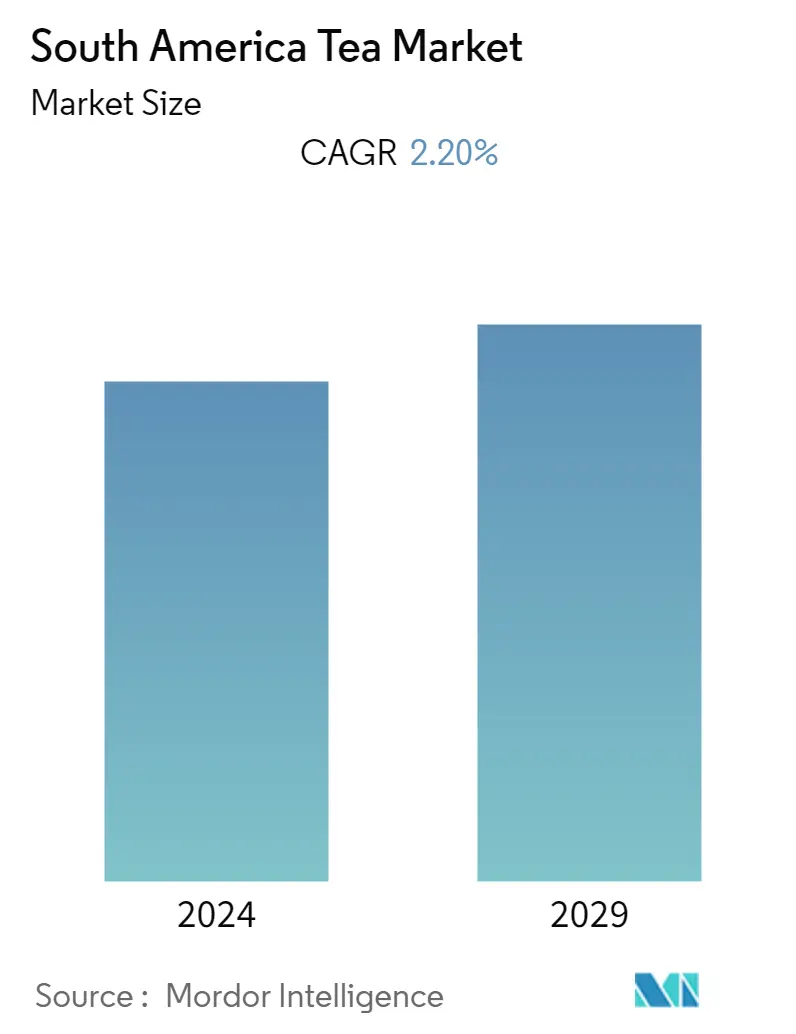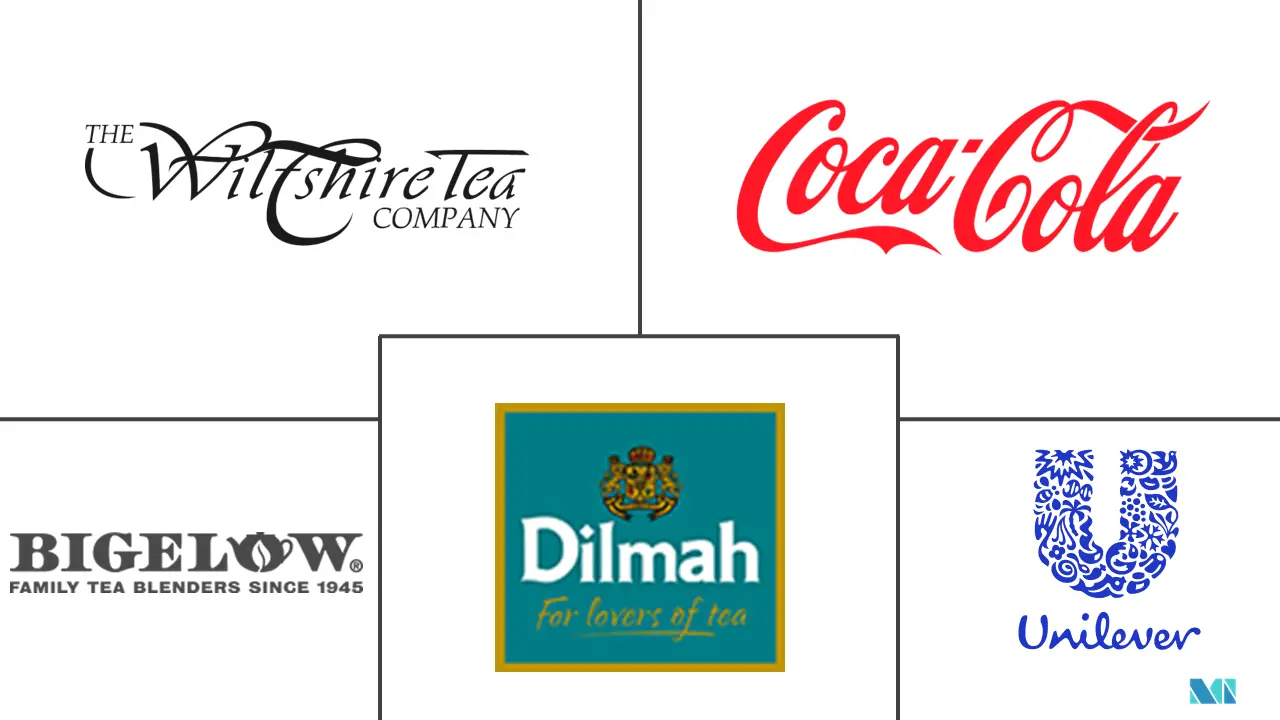Market Size of South America Tea Industry

| Study Period | 2019 - 2029 |
| Base Year For Estimation | 2023 |
| Forecast Data Period | 2024 - 2029 |
| Historical Data Period | 2019 - 2022 |
| CAGR | 2.20 % |
| Market Concentration | Low |
Major Players
*Disclaimer: Major Players sorted in no particular order |
South America Tea Market Analysis
The South America Tea market is forecasted to register a CAGR of 2.2% over the next five years.
Countries in South America, such as Brazil, Argentina, and others are exhibiting a healthy demand for hot tea. Consumers in the regions are becoming more health conscious and their preference for herbal tea, green tea, and organic tea is also increasing. The increasing prevalence of obesity is a major issue in the region. According to World Obesity Atlas, the 2022 report predicted that the prevalence of obesity in Argentina will be 35.8% by 2030. As consumer awareness is increasing, consumption of green tea is increasing as it helps in weight loss. The market players are launching new campaigns and advertisements to make people aware of the benefits of tea consumption. The prominence of health campaigns coupled with the steady demand for green tea is driving the demand for tea in this region.
Demand for herbal tea is also increasing in the region owing to its health benefits and several old age population in the region. According to World Bank data from 2021, 10% of Brazil's population is of age 65 or older. Additionally, owing to the millennial population in the region, the demand for iced tea is also increasing. new flavors of iced tea like peach, mango, strawberry, and many more are attracting young consumers in the region. Premiumization of tea products is gaining prominence among consumers owing to its functional properties, which in turn is expected to boost the growth of the market. The expansion of food service channels has also facilitated the growth of the tea market in South America. Over the medium term, the market is expected to grow owing to the rising disposable income, more working population, and product innovation.
South America Tea Industry Segmentation
Tea is a beverage made from the Camellia sinensis plant. Camellia sinensis is a species of evergreen shrubs or small trees in the flowering plant family Theaceae whose leaves and leaf buds are used to produce tea. Form, type, distribution method, and geography are the market segments for tea in South America. Based on form, it is segmented into leaf tea and CTC tea. By type, the market is segmented into black tea, green tea, herbal tea, and other types. Based on distribution channels, it is segmented into hypermarkets and supermarkets, specialist retailers, convenience stores, online retailers, and other distribution channels. Furthermore, based on geography, it is segmented into Brazil, Argentina, and the rest of South America. For each segment, market sizing and forecasts have been done based on value (in USD million).
| Form | |
| Leaf Tea | |
| CTC Tea (Crush, Tear, Curl) |
| Type | |
| Black Tea | |
| Green Tea | |
| Herbal Tea | |
| Other Types |
| Distribution Channel | |
| Supermarkets/Hypermarkets | |
| Specialty Stores | |
| Convenience Stores | |
| Online Retail Stores | |
| Other Distribution Channels |
| Country | |
| Brazil | |
| Argentina | |
| Rest of South America |
South America Tea Market Size Summary
The South America tea market is experiencing a steady growth trajectory, driven by increasing consumer awareness of health benefits associated with various types of tea. Countries like Brazil and Argentina are witnessing a surge in demand for hot tea, particularly herbal, green, and organic varieties, as consumers become more health-conscious. The rising prevalence of obesity in the region has led to a growing preference for green tea, known for its weight loss benefits. Market players are actively promoting the health advantages of tea through campaigns and advertisements, which, along with the steady demand for green tea, are propelling market growth. The expansion of food service channels and the introduction of new tea flavors, especially iced tea, are further contributing to the market's expansion, appealing to both the older population seeking health benefits and millennials drawn to innovative flavors.
The market is also benefiting from the increasing popularity of ready-to-drink tea options, which offer convenience and a variety of flavors, attracting a broad consumer base. Black tea, in particular, is gaining traction due to its health benefits, including weight loss and cholesterol reduction. The availability of diverse tea products and the willingness of consumers to pay a premium for quality and variety are key factors driving market growth. Additionally, the import and export of tea products are playing a significant role in the market's expansion. Major players in the South American tea market are focusing on product innovation, mergers, and acquisitions to stay competitive. Companies are also adapting to local regulatory requirements while maintaining high safety and quality standards.
South America Tea Market Size - Table of Contents
-
1. MARKET DYNAMICS
-
1.1 Market Drivers
-
1.2 Market Restraints
-
1.3 Porter's Five Forces Analysis
-
1.3.1 Threat of New Entrants
-
1.3.2 Bargaining Power of Buyers/Consumers
-
1.3.3 Bargaining Power of Suppliers
-
1.3.4 Threat of Substitute Products
-
1.3.5 Intensity of Competitive Rivalry
-
-
-
2. MARKET SEGMENTATION
-
2.1 Form
-
2.1.1 Leaf Tea
-
2.1.2 CTC Tea (Crush, Tear, Curl)
-
-
2.2 Type
-
2.2.1 Black Tea
-
2.2.2 Green Tea
-
2.2.3 Herbal Tea
-
2.2.4 Other Types
-
-
2.3 Distribution Channel
-
2.3.1 Supermarkets/Hypermarkets
-
2.3.2 Specialty Stores
-
2.3.3 Convenience Stores
-
2.3.4 Online Retail Stores
-
2.3.5 Other Distribution Channels
-
-
2.4 Country
-
2.4.1 Brazil
-
2.4.2 Argentina
-
2.4.3 Rest of South America
-
-
South America Tea Market Size FAQs
What is the current South America Tea Market size?
The South America Tea Market is projected to register a CAGR of 2.20% during the forecast period (2024-2029)
Who are the key players in South America Tea Market?
Dilmah Ceylon Tea Company PLC., The Wiltshire Tea Company, Unilever Plc, Bigelow Tea Company and The Coca-Cola Company (Honest Tea) are the major companies operating in the South America Tea Market.

